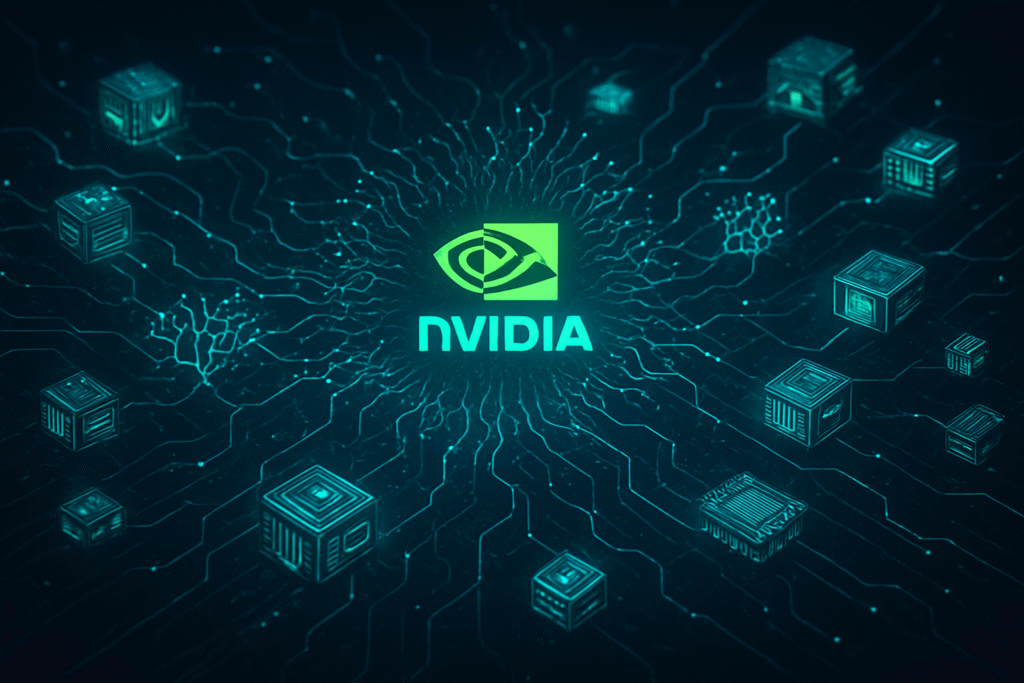
In the fiercely competitive realm of artificial intelligence, Nvidia (NASDAQ: NVDA) is not merely a hardware provider; it's a shrewd architect of the future, wielding a multi-billion-dollar venture capital portfolio to cement its market dominance and catalyze the next wave of AI innovation. As of October 2025, Nvidia's aggressive investment strategy, primarily channeled through its NVentures arm, is reshaping the AI landscape, creating a symbiotic ecosystem where its financial backing directly translates into burgeoning demand for its cutting-edge GPUs and the proliferation of its CUDA software platform. This calculated approach ensures that as the AI industry expands, Nvidia remains at its very core.
The immediate significance of Nvidia's venture capital strategy is profound. It serves as a critical bulwark against rising competition, guaranteeing sustained demand for its high-performance hardware even as rivals intensify their efforts. By strategically injecting capital into AI cloud providers, foundational model developers, and vertical AI application specialists, Nvidia is directly fueling the construction of "AI factories" globally, accelerating breakthroughs in generative AI, and solidifying its platform as the de facto standard for AI development. This isn't just about investing in promising startups; it's about proactively shaping the entire AI value chain to revolve around Nvidia's technological prowess.
The Unseen Architecture: Nvidia's Venture Capital Blueprint for AI Supremacy
Nvidia's venture capital strategy is a masterclass in ecosystem engineering, meticulously designed to extend its influence far beyond silicon manufacturing. Operating through its corporate venture fund, NVentures, Nvidia has dramatically escalated its investment activity, participating in 21 deals in 2025 alone, a significant leap from just one in 2022. By October 2025, the company had participated in 50 venture capital deals, surpassing its total for the previous year, underscoring a clear acceleration in its investment pace. These investments, typically targeting Series A and later rounds, are strategically biased towards companies that either create immediate demand for Nvidia hardware or deepen the moat around its CUDA software ecosystem.
The strategy is underpinned by three core investment themes. Firstly, Cloud-Scale AI Infrastructure, where Nvidia backs startups that rent, optimize, or virtualize its GPUs, thereby creating instant demand for its chips and enabling smaller AI teams to access powerful compute resources. Secondly, Foundation-Model Tooling, involving investments in large language model (LLM) providers, vector database vendors, and advanced compiler projects, which further entrenches the CUDA platform as the industry standard. Lastly, Vertical AI Applications, where Nvidia supports startups in specialized sectors like healthcare, robotics, and autonomous systems, demonstrating real-world adoption of AI workloads and driving broader GPU utilization. Beyond capital, NVentures offers invaluable technical co-development, early access to next-generation GPUs, and integration into Nvidia's extensive enterprise sales network, providing a comprehensive support system for its portfolio companies.
This "circular financing model" is particularly noteworthy: Nvidia invests in a startup, and that startup, in turn, often uses the funds to procure Nvidia's GPUs. This creates a powerful feedback loop, securing demand for Nvidia's core products while fostering innovation within its ecosystem. For instance, CoreWeave, an AI cloud platform provider, represents Nvidia's largest single investment, valued at approximately $3.96 billion (91.4% of its AI investment portfolio). CoreWeave not only receives early access to new chips but also operates with 250,000 Nvidia GPUs, making it both a significant investee and a major customer. Similarly, Nvidia's substantial commitments to OpenAI and xAI involve multi-billion-dollar investments, often tied to agreements to deploy massive AI infrastructure powered by Nvidia's hardware, including plans to jointly deploy up to 10 gigawatts of Nvidia's AI computing power systems with OpenAI. This strategic symbiosis ensures that as these leading AI entities grow, so too does Nvidia's foundational role.
Initial reactions from the AI research community and industry experts have largely affirmed the sagacity of Nvidia's approach. Analysts view these investments as a strategic necessity, not just for financial returns but for maintaining a technological edge and expanding the market for its core products. The model effectively creates a network of innovation partners deeply integrated into Nvidia's platform, making it increasingly difficult for competitors to gain significant traction. This proactive engagement at the cutting edge of AI development provides Nvidia with invaluable insights into future computational demands, allowing it to continuously refine its hardware and software offerings, such as the Blackwell architecture, to stay ahead of the curve.
Reshaping the AI Landscape: Beneficiaries, Competitors, and Market Dynamics
Nvidia's expansive investment portfolio is a potent force, directly influencing the competitive dynamics across the AI industry. The most immediate beneficiaries are the startups themselves, particularly those in the nascent stages of AI development. Companies like CoreWeave, OpenAI, xAI, Mistral AI, Cohere, and Together AI receive not only crucial capital but also unparalleled access to Nvidia's technical expertise, early-stage hardware, and extensive sales channels. This accelerates their growth, enabling them to scale their operations and bring innovative AI solutions to market faster than would otherwise be possible. These partnerships often include multi-year GPU deployment agreements, securing a foundational compute infrastructure for their ambitious AI projects.
The competitive implications for major AI labs and tech giants are significant. While hyperscalers like Amazon (NASDAQ: AMZN) AWS, Alphabet (NASDAQ: GOOGL) Google Cloud, and Microsoft (NASDAQ: MSFT) Azure are increasingly developing their own proprietary AI silicon, Nvidia's investment strategy ensures that its GPUs remain integral to the broader cloud AI infrastructure. By investing in cloud providers like CoreWeave, Nvidia secures a direct pipeline for its hardware into the cloud, complementing its partnerships with the hyperscalers. This multi-pronged approach diversifies its reach and mitigates the risk of being sidelined by in-house chip development efforts. For other chip manufacturers like Advanced Micro Devices (NASDAQ: AMD) and Intel (NASDAQ: INTC), Nvidia's strategy presents a formidable challenge. By locking in key AI innovators and infrastructure providers, Nvidia creates a powerful network effect that reinforces its dominant market share (over 94% of the discrete GPU market in Q2 2025), making it exceedingly difficult for competitors to penetrate the burgeoning AI ecosystem.
Potential disruption to existing products or services is primarily felt by those offering alternative AI compute solutions or platforms. Nvidia's investments in foundational model tooling and AI infrastructure providers further entrench its CUDA platform as the industry standard, potentially marginalizing alternative software stacks. This strategic advantage extends to market positioning, where Nvidia leverages its financial clout to co-create the very demand for its products. By supporting a wide array of AI applications, from autonomous systems (e.g., Wayve, Nuro, Waabi) to healthcare (e.g., SoundHound AI), Nvidia ensures its hardware becomes indispensable across diverse sectors. Its strategic acquisition of Aligned Data Centers with Microsoft and BlackRock (NYSE: BLK), along with its $5 billion investment into Intel for unified GPU-CPU infrastructure, further underscores its commitment to dominating AI infrastructure, solidifying its strategic advantages and market leadership for the foreseeable future.
The Broader Tapestry: Nvidia's Investments in the AI Epoch
Nvidia's investment strategy is not merely a corporate maneuver; it's a pivotal force shaping the broader AI landscape and accelerating global trends. This approach fits squarely into the current era of "AI factories" and massive infrastructure build-outs, where the ability to deploy vast amounts of computational power is paramount for developing and deploying next-generation AI models. By backing companies that are building these very factories—such as xAI and OpenAI, which are planning to deploy gigawatts of Nvidia-powered AI compute—Nvidia is directly enabling the scaling of AI capabilities that were unimaginable just a few years ago. This aligns with the trend of increasing model complexity and the demand for ever-more powerful hardware to train and run these sophisticated systems.
The impacts are far-reaching. Nvidia's investments are catalyzing breakthroughs in generative AI, multimodal models, and specialized AI applications by providing essential resources to the innovators at the forefront. This accelerates the pace of discovery and application across various industries, from drug discovery and materials science to autonomous driving and creative content generation. However, potential concerns also emerge. The increasing centralization of AI compute power around a single dominant vendor raises questions about vendor lock-in, competition, and potential bottlenecks in the supply chain. While Nvidia's strategy fosters innovation within its ecosystem, it could also stifle the growth of alternative hardware or software platforms, potentially limiting diversity in the long run.
Comparing this to previous AI milestones, Nvidia's current strategy is reminiscent of how early computing paradigms were shaped by dominant hardware and software stacks. Just as IBM (NYSE: IBM) and later Microsoft defined eras of computing, Nvidia is now defining the AI compute era. The sheer scale of investment and the depth of integration with its customers are unprecedented in the AI hardware space. Unlike previous eras where hardware vendors primarily sold components, Nvidia is actively co-creating the demand, the infrastructure, and the applications that rely on its technology. This comprehensive approach ensures its foundational role, effectively turning its investment portfolio into a strategic lever for industry-wide influence.
Furthermore, Nvidia's programs like Inception, which supports over 18,000 startups globally with technical expertise and funding, highlight a broader commitment to democratizing access to advanced AI tools. This initiative cultivates a global ecosystem of AI innovators who are deeply integrated into Nvidia's platform, ensuring a continuous pipeline of talent and ideas that further solidifies its position. This dual approach of strategic, high-value investments and broad ecosystem support positions Nvidia not just as a chipmaker, but as a central orchestrator of the AI revolution.
The Road Ahead: Navigating AI's Future with Nvidia at the Helm
Looking ahead, Nvidia's strategic investments promise to drive several key developments in the near and long term. In the near term, we can expect a continued acceleration in the build-out of AI cloud infrastructure, with Nvidia's portfolio companies playing a crucial role. This will likely lead to even more powerful foundation models, capable of increasingly complex tasks and multimodal understanding. The integration of AI into enterprise applications will deepen, with Nvidia's investments in vertical AI companies translating into real-world deployments across industries like healthcare, logistics, and manufacturing. The ongoing collaborations with cloud giants and its own plans to invest up to $500 billion over the next four years in US AI infrastructure will ensure a robust and expanding compute backbone.
On the horizon, potential applications and use cases are vast. We could see the emergence of truly intelligent autonomous agents, advanced robotics capable of intricate tasks, and personalized AI assistants that seamlessly integrate into daily life. Breakthroughs in scientific discovery, enabled by accelerated AI compute, are also a strong possibility, particularly in areas like materials science, climate modeling, and drug development. Nvidia's investments in areas like Commonwealth Fusion and Crusoe hint at its interest in sustainable compute and energy-efficient AI, which will be critical as AI workloads continue to grow.
However, several challenges need to be addressed. The escalating demand for AI compute raises concerns about energy consumption and environmental impact, requiring continuous innovation in power efficiency. Supply chain resilience, especially in the context of geopolitical tensions and export restrictions (particularly with China), remains a critical challenge. Furthermore, the ethical implications of increasingly powerful AI, including issues of bias, privacy, and control, will require careful consideration and collaboration across the industry. Experts predict that Nvidia will continue to leverage its financial strength and technological leadership to address these challenges, potentially through further investments in sustainable AI solutions and robust security platforms.
What experts predict will happen next is a deepening of Nvidia's ecosystem lock-in. As more AI companies become reliant on its hardware and software, switching costs will increase, solidifying its market position. We can anticipate further strategic acquisitions or larger equity stakes in companies that demonstrate disruptive potential or offer synergistic technologies. The company's substantial $37.6 billion cash reserve provides ample stability for these ambitious plans, justifying its high valuation in the eyes of analysts who foresee sustained growth in AI data centers (projected 69-73% YoY growth). The focus will likely remain on expanding the AI market itself, ensuring that Nvidia's technology remains the foundational layer for all future AI innovation.
The AI Architect's Legacy: A Concluding Assessment
Nvidia's investment portfolio stands as a testament to a visionary strategy that transcends traditional semiconductor manufacturing. By actively cultivating and funding the ecosystem around its core products, Nvidia has not only secured its dominant market position but has also become a primary catalyst for future AI innovation. The key takeaway is clear: Nvidia's venture capital arm is not merely a passive financial investor; it is an active participant in shaping the technological trajectory of artificial intelligence, ensuring that its GPUs and CUDA platform remain indispensable to the AI revolution.
This development's significance in AI history is profound. It marks a shift where a hardware provider strategically integrates itself into the entire AI value chain, from infrastructure to application, effectively becoming an AI architect rather than just a component supplier. This proactive approach sets a new benchmark for how technology companies can maintain leadership in rapidly evolving fields. The long-term impact will likely see Nvidia's influence permeate every facet of AI development, with its technology forming the bedrock for an increasingly intelligent and automated world.
In the coming weeks and months, watch for further announcements regarding Nvidia's investments, particularly in emerging areas like edge AI, quantum AI integration, and sustainable compute solutions. Pay close attention to the performance and growth of its portfolio companies, as their success will be a direct indicator of Nvidia's continued strategic prowess. The ongoing battle for AI compute dominance will intensify, but with its strategic billions, Nvidia appears well-positioned to maintain its formidable lead, continuing to define the future of artificial intelligence.
This content is intended for informational purposes only and represents analysis of current AI developments.
TokenRing AI delivers enterprise-grade solutions for multi-agent AI workflow orchestration, AI-powered development tools, and seamless remote collaboration platforms.
For more information, visit https://www.tokenring.ai/.





